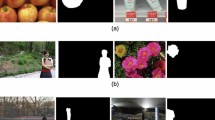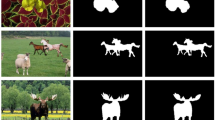Abstract
Image forgery detection focuses more on tampering regions than image content of semantic segmentation, it is revealed that wealthier features need to be learned. Moreover, insufficient semantic information causes low efficiency of forgery detection. To address these issues, we propose a hybrid features and semantic reinforcement network (HFSRNet) for image forgery detection, which is an encoding and decoding based network. Specifically, long-short term memory with resampling features has been applied to capture traces from the image patches for finding manipulating artifacts. Consolidated features extracted from rotating residual units are further leveraged to amplify the discrepancy between un-tampered and tampered regions. We then hybridize features from them through a concatenation to further incorporate spatial co-occurrence of these two modalities. In addition, for achieving the semantic consistency between two same level features associated by across layers, semantic reinforcement is implemented on the decoding stage. HFSRNet is an end-to-end architecture that handles multiple types of image forgery including copy-move, splicing, removal. Experiments on three standard image manipulation datasets (NIST16, COVERAGE and CASIA) demonstrate that HFSRNet obtains state-of-the-art performance compared to existing models and baselines.






Similar content being viewed by others
References
Cozzolino, D., Poggi, G., Verdoliva, L.: Efficient dense-field copy-move forgery detection. IEEE Trans. Inf. Forens. Secur. 10(11), 2284–2297 (2015)
Wen, B.H., Zhu, Y., Subramanian, R., Ng, T.T., Shen, X.J., Winkler, S.: Coverage a novel database for copy-move forgery detection. In: IEEE International Conference on Image processing (ICIP), pp. 161–165 (2016)
Cozzolino, D., Poggi, G., Verdoliva, L.: Splicebuster: A new blind image splicing detector. In: IEEE International Workshop on Information Forensics and Security (WIFS), pp. 1–6 (2015)
Wu, Y., Abd-Almageed, W., Natarajan, P.: Deep matching and validation network: an end-to-end solution to constrained image splicing localization and detection. In: ACM on Multimedia Conference (MM), pp. 1480–1502 (2017)
Zhu, X.S., Qian, Y.J., Zhao, X.F., Sun, B., Sun, Y.: A deep learning approach to patch-based image inpainting forensics. Signal Process. Image Commun. 67, 90–99 (2018)
Bayar, B., C, M.: A deep learning approach to universal image manipulation detection using a new convolutional layer. In: ACM Workshop on Information Hiding & Multimedia Security, pp. 5–10 (2016)
Han, J.G., Park, T.H., Moon, Y.H., Eom, I.K.: Efficient Markov feature extraction method for image splicing detection using maximization and threshold expansion. J. Electron. Imaging 25(2), 023031 (2016)
Asghar, K., Habib, Z., Hussain, M.: Copy-move and splicing image forgery detection and localization techniques: a review. Aust. J. Forensic Sci 49(3), 281–307 (2017)
Yang, Q., Peng, F., Li, J.-T., Long, M.: Image tamper detection based on noise estimation and lacunarity texture. Multim. Tools Appl. 75(17), 10201–10211 (2016)
Girshick, R.: Fast R-CNN. In: International Conference on Computer Vision (ICCV), pp. 1440–1448 (2015)
Zhou, B., Lapedriza, A., Xiao, J., Torralba, A., Oliva, A.: Learning deep features for scene recognition using places database. In: Advances in neural information processing systems (NIPS), pp. 487–495 (2014)
Long, J., Shelhamer, E., Darrell, T.: Fully convolutional networks for semantic segmentation. In: Computer Vision and Pattern Recognition (CVPR), pp. 3431–3440 (2015)
Zheng, S., Jayasumana, S., Romera-Paredes, B., Vineet, V., Su, Z., Du, D., Huang, C., Torr, P.H.: Conditional random fields as recurrent neural networks. In: International Conference on Computer Vision (ICCV), pp. 1529–1537 (2015)
Badrinarayanan, V., Kendall, A., Cipolla, R.: Segnet: a deep convolutional encoder-decoder architecture for scene segmentation. IEEE Trans. Pattern Anal. Mach. Intell. 39(12), 2481–2495 (2017)
Rao, Y., Ni, J.Q.: A deep learning approach to detection of splicing and copy-move forgeries in images. In: IEEE International Workshop on Information Forensics and Security (WIFS), pp. 1–6 (2016)
Bi,X., Wei, Y., Xiao, B., Li, W.: RRU-Net: The Ringed Residual U-Net for Image Splicing Forgery Detection. In: IEEE/CVF Conference on Computer Vision and Pattern Recognition Workshops (CVPRW), pp. 30–39 (2019)
Bappy, J.H., Roy-Chowdhury, A.K., Bunk, J., Nataraj, L., Manjunath, B.: Exploiting spatial structure for localizing manipulated image regions. In: International Conference on Computer Vision (ICCV), pp. 4980–4989 (2017)
Bappy, J.H., Simons, C., Nataraj, L., Manjunath, B.S., Roy-Chowdhury, A.K.: Hybrid LSTM and encoder-decoder architecture for detection of image forgeries. IEEE Trans. Image Process. 28(7), 3286–3300 (2019)
NIST manipulation evaluation dataset. https://www.nist.gov/itl/iad/mig/nimble-challenge-2017-evaluation/ (2016). Accessed 4 Aug 2017
Dong, J., Wang, W., Tan, T.: Casia image tampering detection evaluation database. In: 2013 IEEE China Summit and International Conference on Signal and Information Processing (ChinaSIP), pp. 422–426 (2013)
Mahdian, B., Saic, S.: Using noise inconsistencies for blind image forensics. Image Vis. Comput. 27(10), 1497–1503 (2009)
Nataraj, L., Sarkar, A., Manjunath, B.S.: Improving re-sampling detection by adding noise. In: Conference on Media Forensics and Security II. 7541, 75410I (2010)
Krawetz, N.: A picture’s worth... Hacker Factor Solutions. 6 (2007)
Ferrara, P., Bianchi, T., De Rosa, A., Piva, A.: Image forgery localization via fine-grained analysis of cfa artifacts. IEEE Trans. Inf. Forensics Secur. 7(5), 1566–1577 (2012)
Salloum, R., Ren, Y., et al.: Image splicing localization using a multi-task fully convolutional network (mfcn). J. Vis. Commun. Image Represent. 51, 201–209 (2018)
Tan, H.C., Liu, X.P., Liu, M., Yin, B.C., Li, X.: KT-GAN: knowledge-transfer generative adversarial network for text-to-image synthesis. IEEE Trans. Image Process. 30, 1275–1290 (2021)
Fridrich, J., Kodovsky, J.: Rich models for steganalysis of digital images. IEEE Trans. Inf. Forensics Secur. 7(3), 868–882 (2012)
Bayar, B., Stamm, M.C.: Constrained convolutional neural networks: a new approach towards general purpose image manipulation detection. IEEE Trans. Inf. Forensics Secur. 13(11), 2691–2706 (2018)
Zhou, P., Han, X., Morariu, V.I., Davis, L.S.: Learning rich features for image manipulation detection. In: Conference on Computer Vision and Pattern Recognition (CVPR), pp. 1053–1061 (2018)
Huizhou, L., Chao, Y., Fangting, L., Bin, J.: Constrained R-CNN: a general image manipulation detection model. In: International Conference on Multimedia and Expo (ICME), pp. 1–6 (2020)
Li, J., Li, X., Yang, B., Sun, X.: Segmentation-based image copy-move forgery detection scheme. IEEE Trans. Inf. Forensics Secur. 10(3), 507–518 (2015)
Bunk, J., Bappy, J.H., Mohammed, T.M., Nataraj, L., Flenner, A., Manjunath, B.S., Chandrasekaran, S., Roy-Chowdhury, A.K., Peterson, L.: Detection and Localization of Image Forgeries Using Resampling Features and Deep Learning. In: Computer Vision and Pattern Recognition Workshops (CVPRW), pp. 1881–1889 (2017)
Moon, B., Jagadish, H.V., Faloutsos, C., Saltz, J.H.: Analysis of the clustering properties of the Hilbert space-filling curve. IEEE Trans. Knowl. Data Eng. 13(1), 124–141 (2001)
Kingma, D., Ba, J.: Adam: A method for stochastic optimization. In: International Conference on Learning Representations (2014)
Gloe, T., Bohme, R.: The Dresden image database for benchmarking digital image forensics. J. Dig. Forensic Pract. 3(2–4), 150–159 (2010)
Mazaheri, G., Mithun, N.C., Bappy, J.H., Roy-Chowdhury, A.K.: A skip connection architecture for localization of image manipulations. In: Proceedings, IEEE Conference Computing Vision, Pattern Recognition, pp. 119–129 (2019)
Acknowledgements
This research is supported by the National Key Research and Development Program of China (2018YFB0804203), Regional Joint Fund of NSFC (U19A2057), the National Natural Science Foundation of China (61672259, 61876070), and the Jilin Province Science and Technology Development Plan Project(20190303134SF, 20180201064SF).
Author information
Authors and Affiliations
Corresponding author
Additional information
Publisher's Note
Springer Nature remains neutral with regard to jurisdictional claims in published maps and institutional affiliations.
Rights and permissions
About this article
Cite this article
Chen, H., Chang, C., Shi, Z. et al. Hybrid features and semantic reinforcement network for image forgery detection. Multimedia Systems 28, 363–374 (2022). https://doi.org/10.1007/s00530-021-00801-w
Received:
Accepted:
Published:
Issue Date:
DOI: https://doi.org/10.1007/s00530-021-00801-w




